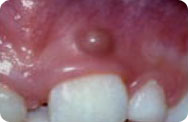Fillings
I. Materials
a) Amalgam
Amalgam has been used for over 150 years as a dental restorative material. Less than 20 years ago, assistants mixed the material by hand (without the use of gloves). That being said, it has both advantages and disadvantages. The advantage is that it is relatively inert, moisture tolerant, durable, easy to place, low cost, strong and bacteriostatic. However, it does contain 2-3% mercury. It is this mercury component that allows the metal to be malleable and pushed into the spaces that a filling must occupy. It hardens within 24 hours and can last for more than 20 years.
There has been a lot of controversy related to the use of amalgam because of its mercury content. There are studies that can be quoted on either side of the argument of whether it's safe in humans. Amalgam is still used in dentistry because we have not found a suitable replacement.
What is amalgam? Amalgam is a mixture of metals.
• > 40% silver (Ag)
• < 32% tin (Sn)
• < 30% copper (Cu)
• < 2% zinc (Zn)
• < 3% mercury (Hg)
Anyone with metal sensitivities or allergic reactions to the above metals may not be a good candidate for amalgam fillings.
Mercury in Drug and Biologic Products (FDA US Food and Drug Administration): Link
Amalgam is still used in pediatric dentistry for primary molars because it is fast to place (which may be a factor in a young child), cost effective (these teeth fall out), easy to place without the need for complete moisture control and usually will not need to be replaced.
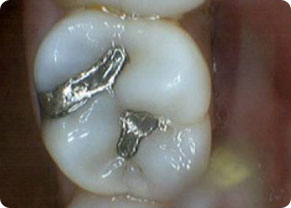
Amalgam Filling
b) Composite
A Composite is a plastic polymer material which is cured or hardened with a light source. It comes in many shades so it can be matched to the tooth colour. It is very malleable and therefore can be used to mimic the shape and form of a natural tooth. It is less durable than amalgam especially in the posterior areas that undergo a lot of wear or occlusal forces. It does not have the bacteriostatic characteristics and therefore can be associated with recurrent decay near the margins (the location where the tooth structure and composite material touch).
It is very technique sensitive and therefore it must be placed in a well isolated tooth to avoid moisture from saliva, water or moisture within the patient's breath. It usually needs to be placed in increments to control the amount of shrinkage and therefore strain it can place on the tooth's walls within the filling space. Because of this shrinkage, it has been associated with causing sensitivities after its placement which can last for many months. Composite is used because of its esthetic results.
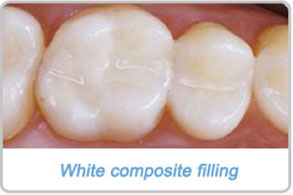
c) Glass Ionomer
A Glass ionomer is composed of a mixture of glass and an organic acid that are chemically set by an acid-base reaction. Thus the glass ionmer needs to have time to fully set and harden. Unlike composites, they do not undergo shrinkage, microleakage and are not susceptible to moisture. Glass ionomers contain and can release fluoride which can prevent further cavities on adjacent tooth surface.
Glass ionomer fillings are tooth coloured but are not as strong as composite fillings.
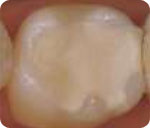
A Glass Ionomer Filling
d) Resin Modified
Glass Ionomer
It is a combination of glass-ionomer and composite resin – a mixture of glass, an organic acid and resin polymer that will harden when light cured.
e) Compomere
A compomere is a hybrid material, which attempts to mix the characteristics of both the composite and glass ionomer materials.
f) Stainless Steel
Crown
These are metal pre-fabricated shells that fit over top of the prepared tooth. These fillings are used when the caries occupies a large surface area of the tooth, the tooth is affected by a developmental defect such as enamel hypoplasia or the tooth requires a pulpal or nerve treatment which renders the tooth hollow and susceptible to fracture.
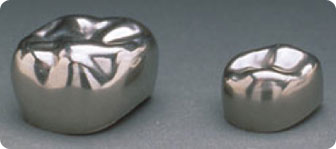
• Duplicate the anatomy of primary molars.
• Manufactured with a life-like height, contour, and occlusal surface.
• Pre-crimped at the cervical margin to give good retention.
• Smooth stainless steel surface helps to maintain gingival health and patient comfort.
Contents of a stainless steel crown:
Carbon 0.12
Manganese 2.00
Silicon 1.00
Phosphorus 0.04
Sulphur 0.03
Chromium 17.0-19.0
Nickel 10.0-13.0
Molybdenum 0.75
Copper 0.75
Iron balance
Element Nominal (1% composition)
II. Nerve Treatments
When caries touches or affects the pulpal tissues of a primary tooth, the pulpal tissues requires treatment. In pediatric (baby) teeth the nerve treatment consists of either a pulpotomy or pulpectomy procedures. The most common procedure is the pulpotomy, where the pulpal tissues are removed from the pulp chamber (upper portion of the nerve). The purpose for removing these tissues is to remove the pulpal tissues that may have been penetrated by bacteria from the cavity. The pulp chamber is cleansed and remaining pulp stumps medicated. An inert material is placed within the pulp chamber and a stainless steel crown is cemented on to the tooth. The permanent tooth's pulpal tissues are not continuous with the primary tooth.
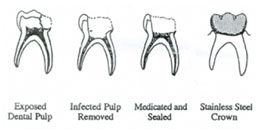
A pulpectomy procedure requires the removal of all the pulpal tissues within the root of the tooth in addition to the pulp chamber. This procedure can be considered if the second primary molar tooth is required to maintain space and alignment of the eruption of the first permanent molar.
III. Extraction
Although we always strive to restore or fix teeth, if the infection has reached the bone sometimes the extraction or removal of the primary tooth is the best treatment. An abcess can appear like a bubble on the gum, a swollen cheek or an atypically mobile tooth. The abcess tooth can be associated with pain but not always. The infection can damage the soft tissues, bone and even the unerupted permanent tooth. In extreme cases the infection can become systemic and travel throughout the body and become a serious health risk which may require hospitalization.
